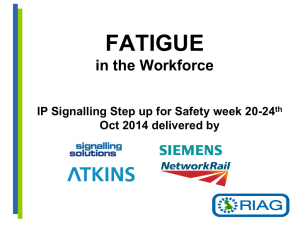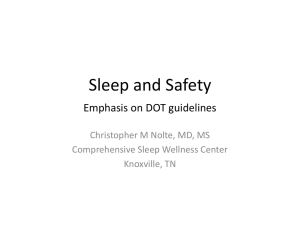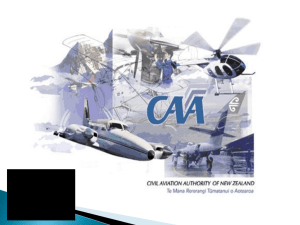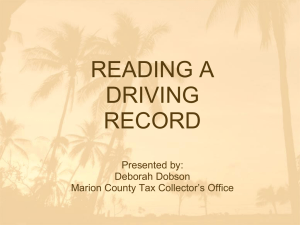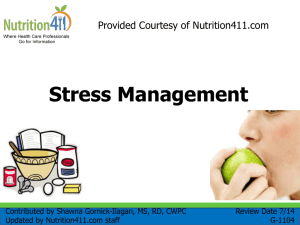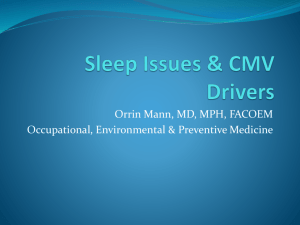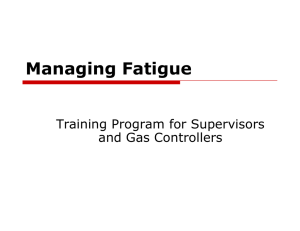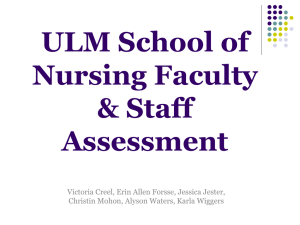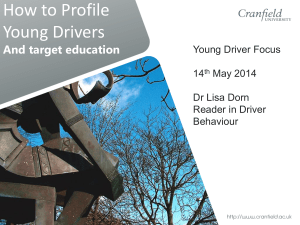Distracted Driving - West Virginia Association for Pupil Transportation
advertisement
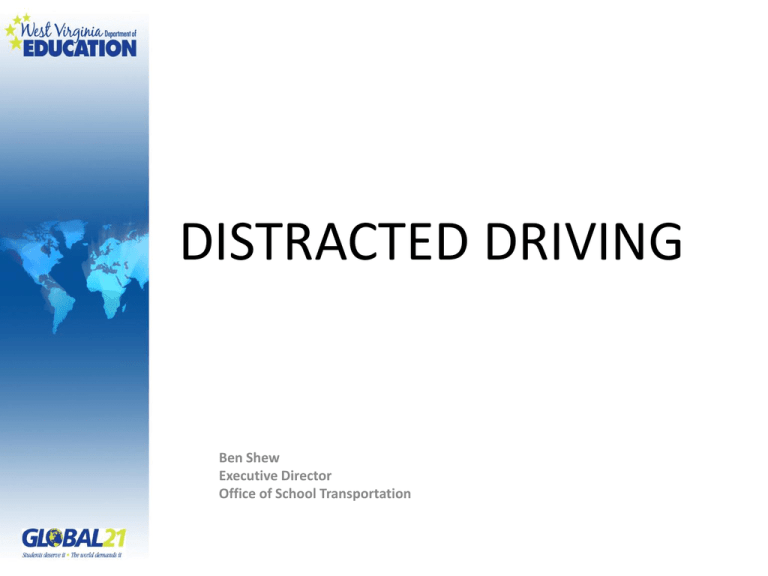
DISTRACTED DRIVING Ben Shew Executive Director Office of School Transportation http://www.youtube.com/watch?v =jqBlL4Wujkw Texting While Driving Safety is Our Business • The School Bus is safe • Pre-trip • Post-trip • Bus Operators are safe • Well trained • Physically fit • Mentally alert Safe Operators • This year WV had no student deaths • Fewer serious accidents • Nationally there is a concern about distracted driving – Distracted Driving includes: • • • • Use of electronic devices Eating and drinking Conversations Fatigue Safe Operations • Driving while distracted is a factor in 25 percent of police reported crashes • Distracted driving injures 330,000 people every year • Behavior Increased Risk • Texting 23 times • Reaching for a moving object 9 times • Driving drowsy 4 times • Looking at an external object 3.7 times • Reading 3.4 times • Applying makeup 3 times FMCSA Regulation Docket No. FMCSA-2009-0370 final rule • Prohibits testing by CMV drivers including school bus operators • Waiver for government operated school buses drivers • Not exempt from CDL disqualification by State • Web access: http://www.fmcsa.dot.gov/rulesregulations/administration/rulemakings/final/TextingBan-Final-Rule-plus-OST-press-release.pdf WV Cell Phone and Electronic Device Policy • Cell phone and other electronic communication devices • Cell phone usage while driving are being compared to DUI • Policy 4336 - 13.20 Cellular Phones • 13.20.1 The use of cellular phones or other portable electronic devices – even those equipped with hands-free devices – while driving is prohibited • 13.20.2 The use of cellular phones while supervising the loading and unloading of students is prohibited. • 13.20.3 If communication with the Transportation Department is necessary, the bus must be stopped. Electronic Devices • Distraction from cell phone use while driving (hand held or hands free) extends a driver's reaction as much as having a blood alcohol concentration at the legal limit of .08 percent. (University of Utah) • The No.1 source of driver inattention is use of a wireless device. (Virginia Tech/NHTSA) • Use of, or reach for, an electronic device made the risk of crash or near-crash event 6.7 times as high as non-distracted driving(VPI) • Driving while using a cell phone reduces the amount of brain activity associated with driving by 37 percent (Carnegie Mellon) Texting • It takes your eyes off the road for an average of 5 seconds. • It's like driving after having 4 bottles of beer. • It makes you 23 times more likely to crash. • "This equates to a driver traveling the length of a football field at 55 mph without looking at the roadway," Virginia Tech found. Another Consequence Oak Hill, Ohio School Bus Driver Terminated for Texting Driver Fatigue • National Transportation Board (NTSB) • “Fatigue can impair a person behind a wheel much like alcohol or other drugs. We must ensure that as much as possible is being done to protect our transportation system from the insidious effect of human fatigue.” • Fatigue Quiz (True or False) • Coffee overcomes effects of drowsiness • I can tell when I’m going to sleep • Rolling down the window or singing will keep me awake • You can stockpile sleep on the weekends • Most adults need only 5 hours of sleep • A microsleep lasts 2 seconds Driver Fatigue • Sleepiness Impairs Performance • Slower reaction time • Even small decrements in reaction time can have a profound effect on crash risk, particularly at high speeds • Reduced vigilance • Performance declines, including increased periods on non-responding or delayed responding • Deficits in information processing • Processing and integration info takes longer, the accuracy of short-term memory decreases and performance declines Driver Fatigue • Crash Characteristics • They occur normally at night or mid-afternoon • Crash likely to be serious • Driver does not try to avoid crash • Crash occurs on high-speed roadway • Risks for Drowsy-Driving Crashes • • • • • Sleep Loss – 7 to 8 hours of sleep Driving patterns – Changes in normal habit, 3 hrs. or more driving increases risk. Use of sedating meds – Meds have been provided to counties Untreated sleep disorders – sleep apnea and narcolepsy Alcohol – 20 % of fall-asleep crashes involve alcohol Driver Fatigue • Behavioral Interventions • 15 to 20 minute nap • Consuming caffeine – min. 2 cups only effective for a short time • Physical discomfort Driver Fatigue • Driver fatigue • Policy 4336 is similar to FMCSA’s Hours of Service Regulations • 14.2 Be eligible to operate a school bus without a minimum of six (6) consecutive hours of off duty time, for proper rest between the conclusion of the previous day’s regularly scheduled afternoon run and immediately prior to the beginning of the next day’s regularly scheduled morning run. Also: • 14.2.a. More than 10 hours following 8 consecutive hours off duty; or • 14.2.b. For any period after having been on duty 15 hours following 8 consecutive hours off duty • 14.2.c. No school bus operator shall drive a passengercarrying commercial motor vehicle, regardless of the number of motor carriers using the driver's services, for any period after: • 14.2.c.1. Having been on duty 60 hours in any 7 consecutive days if the employing motor carrier does not operate commercial motor vehicles every day of the week; or • 14.2.c.2. Having been on duty 70 hours in any period of 8 consecutive days if the employing motor carrier operates commercial motor vehicles every day of the week. Sleep Apnea • According to the Federal Motor Carrier Safety Administration (FMCSA) a driver having Obstructive Sleep Apnea (OSA) precludes an individual from obtaining unconditional certification to drive a commercial motor vehicle(CMV). However, it should not exclude all individuals with the disorder. An individual with an OSA diagnosis and is receiving positive airway pressure (PAP) may be certified to drive if that individual meets the following criteria: • Be referred to a clinician with relevant expertise • Adequate PAP pressure established through one of the following means: • An in-laboratory titration study • An auto-titration system without an in-laboratory titration Sleep Apnea (cont’d) • • Individuals with OSA who have been treated with PAP may be certified if they have been successfully treated for a minimum of 1 week • Successful PAP treatment is defined as follows: • Demonstration of good compliance with treatment • Resolution of excessive sleepiness when driving Individuals with OSA who are treated with PAP must demonstrate compliance with treatment and this must be documented objectively • Compliance is defined as using PAP for the duration of total sleep time. • Optional treatment efficacy occurs with seven hours or more of use during sleep; however, four hours of documented time at pressure per major sleep episode is minimally acceptable. • Based on current standards of practice, and acceptable CPAP use is at least 4 hours of use per night on at least 70% of nights. Why You may ask why do we have these requirements when we are exempt from federal regulations • It is the right thing to do for the safety of the students • It is the “best practice” • We are exempt because we are the safest form of transportation and we police ourselves Questions??
